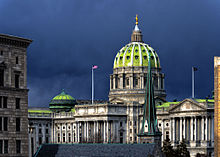The following is a list of neighborhoods, districts, and other sections located in the city of Harrisburg, Pennsylvania. The list is organized by broader geographical sections within the city. While there is no official list of neighborhoods, districts, and places, this list was compiled from the sources listed in the References and External links sections, as well as from published information from secondary sources.
Common usage for Harrisburg's neighborhood names does not respect "official" borders used by the city's police, planning commission or other entities. Therefore, some of the places listed here may overlap geographically, and residents do not always agree where one neighborhood ends and another begins. Some names are past neighborhoods or developments that no longer exist (such as " Hardscrabble").
Historically, neighborhood development has followed ward boundaries, but many neighborhoods and historic districts have been re-shaped by community leaders, the Harrisburg Architectural Review Board, and planning organizations in the post-industrial era. [1]
Historian Jeb Stuart wrote of the overlapping patchwork of neighborhoods, while "potentially confusing, only speaks positively to the ongoing quest of the citizenry in naming and building community cohesiveness in the areas in which they live." Neighborhoods distinguish themselves through architecture, construction, time period, setting, topography and reasons for development. [2]
Allison Hill
The Allison Hill district boundary includes Arsenal Boulevard and Herr Street to the north, 19th Street to the east, I-83 to the south, and the bluff along Cameron Street to the west. [3]
- Central Allison Hill
- North Allison Hill
- Sibletown [4] (antiquated, now William Howard Day and M.W. Smith Homes)
- South Allison Hill
- Springdale [4] (antiquated)
- Summit Terrace
City Island
City Island is a mile-long island owned by the city in the Susquehanna River. There are no residences; the area is used for recreation and extra city vehicle equipment storage.
Downtown

The boundary of Harrisburg's Downtown is considered Forster Street to the north, I-83 to the south, the railroad tracks to the east, and the Susquehanna River to the west.
- Bull Run [5] (antiquated)
- Capitol District
- Eighth Ward [5] (antiquated)
- Judytown (antiquated)
- Market Square
- Maclaysburg (antiquated)
- Restaurant Row
- Shipoke
- South of Market (SoMa)
East Harrisburg
The East Harrisburg district boundary includes Reservoir Park and Market Street to the north, the city line to the east, the railroad tracks to the south, and 18th Street to the west. Smaller rowhouse neighborhoods and detached homes in Bellevue Park make up this area, in addition to commercial corridors along South 29th and Derry Streets, an industrial corridor adjacent to the railroad tracks, and larger institutional uses such as John Harris High School, the Marshall Math Science Academy, and the former Bishop McDevitt High School. [6]
Midtown
The Midtown district boundary includes Maclay Street to the north, 7th Street to the east, Forster Street to the south, and Front Street to the west.
- Capitol Heights
- Cumberland Court
- Engleton
- Fox Ridge
- Hardscrabble (antiquated, demolished)
- Verbeketown (antiquated)
South Harrisburg
The South Harrisburg district boundary includes I-83 to the north, the city line to the south and east, and the Susquehanna River to the west.
- Cloverly Heights
- Frog Hollow [7] (antiquated, demolished)
- Hall Manor
- Hoverter Homes
- Lochiel [8] (antiquated)
- Sheesleytown [9] (antiquated, demolished)
Uptown
The boundary of the Uptown district is the city limits to the north, 7th Street to the east, Maclay Street to the south, and Front Street to the west.
- Academy Manor
- Camp Curtin
- Cottage Ridge [4] [10] (antiquated)
- Curtin Heights [11] (antiquated)
- Landmark
- Riverside
- Schuddemageville [12] [4] (antiquated)
Historic Districts
- 6th Street Historic District
- Allison Hill Historic District
- Bellevue Park Historic District
- Old Downtown Commercial Historic District
- Fox Ridge Historic District
- Historic Harrisburg Historic District
- Old Midtown Historic District
- Mount Pleasant Historic District
- Pennsylvania Capitol Historic District
- Olde Uptown Historic District
See also
External links
- City of Harrisburg, Center City Aerial Illustration
- City of Harrisburg Visitors Guide to districts and neighborhoods
References
- ^ Harrisburg ward map Archived 2010-05-28 at the Wayback Machine City of Harrisburg, accessed February 5, 2010.
- ^ Stuart, Jeb (Spring 2023). "Juggling Harrisburg Neighborhood Names Points to Community Pride". Harrisburg Heritage. Historic Harrisburg Association.
- ^ "Comprehensive Plan 2020" (PDF). City of Harrisburg. July 2020. Retrieved 2021-07-01.
- ^ a b c d Beers, Paul (2011). City contented, city discontented : a history of modern Harrisburg. Midtown Scholar Press ; Design by Fathom Studio ; Copyright by Midtown Scholar Bookstore, Mechanicsburg. ISBN 978-0-9839571-0-2. OCLC 761221337.
- ^ a b Scott, John Weldon (2005). African Americans of Harrisburg. Eric Ledell Smith, African American Museum of Harrisburg. Charleston, SC: Arcadia. p. 57. ISBN 0-7385-3668-7. OCLC 57707790.
- ^ "Comprehensive Plan 2020" (PDF). City of Harrisburg. July 2020. Retrieved 2021-07-01.
- ^ The Harrisburg Telegraph 1915.
-
^ Ivory, Karen (2015).
Pennsylvania disasters : true stories of tragedy and survival (2nd ed.). Guilford, Connecticut. p. 55.
ISBN
978-1-4930-1320-3.
OCLC
894301733.
{{ cite book}}: CS1 maint: location missing publisher ( link) - ^ The Harrisburg Telegraph 1915.
- ^ "Cottage Ridge Historical Marker". www.hmdb.org. Retrieved 2022-11-15.
- ^ "North Sixth Street (Houses) - Written Historical and Descriptive Data" (PDF). Library of Congress - Historic American Buildings Survey. Retrieved 2021-07-01.
- ^ "North Sixth Street (Houses) - Written Historical and Descriptive Data" (PDF). Library of Congress - Historic American Buildings Survey. Retrieved 2021-07-01.